Francis Street: The Peacock Inn (no. 135). Keely Ball (nee Griffiths) wrote to tell us, "I thought you may be interested to know that my great grand mother was the licenced victualler there in 1901, her name was Martha Jones, several of her family were living with her at this time, one being her daughter Annie Jones (26yrs), who was my grandmother. Annie married Robert Henry Griffiths on 28th April 1906 and they had my Father Ernest in 1912. I'm pretty new to family research and have yet to trace when they moved there, but in 1881 they lived at 11 Peel Steet in Chester. Would you know if this was also a pub in days gone by and are there any surviving pictures?"
In 1919-20, H F Haswell was the licencee.
The Moulder's Arms. The Chester Chronicle, 26th August 1871 mentioned this inn as trading in Francis Street, its licencee Joesph Williams.
The Dairy Maid. Mentioned in the Cheshire Observer, 4th August 1855 when the place was kept by a Miss Wainwright and her sister, Mrs Francis (same name as the street). Another Dairy Maid was in Frodsham Street- see below.
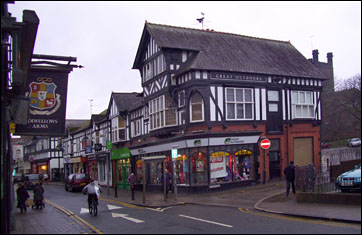 Frodsham Street (formerly Cow Lane): Yates's in Frodsham Street closed its doors for the last time in March 2008. Owners Laurel Group announced in the local press a "national closure programme"- 90 "wet led" outlets (what an ugly phrase!) closing as a result of "the smoking ban and poor trading conditions". Frodsham Street (formerly Cow Lane): Yates's in Frodsham Street closed its doors for the last time in March 2008. Owners Laurel Group announced in the local press a "national closure programme"- 90 "wet led" outlets (what an ugly phrase!) closing as a result of "the smoking ban and poor trading conditions".
There was a time, not so long ago, when Yates's Wine Lodges were fine Dickensian establishments of wooden floors and barrels, full of Breugelesque characters. The drink they sold, notably the 'Large White' ("as good as can be") was a lethal sweet white Aussie wine served in a half pint beer glass, quite unsuitable for almost anybody but seasoned drinkers. We quite liked it. The attempt to suddenly transform this sort of establishment into 'kiddie pubs' never really worked. To quote a wit on the excellent, but sadly now defunct, Chester@Large website, "Once an honourable institution that performed the well-intentioned function of serving inexpensive, but decent quality wine to those who would otherwise have fetched up drinking unspeakable rotgut, it ended up going full circle serving cheap rotgut to an unspeakable clientele".
In late 2009, the old Yates' premises reopened as The Amphitheatre Bar but this in turn closed in April 2012.
A good thing too it seems, as in early 2012, the esteemed Chester Beer Project voted the Amphitheatre Bar as 'The worst pub in Chester'- "Easy choice. A confluence of bad service, bad attitude, bad atmosphere and bad ale made this place the worst boozer we visited in 2011 by a long way. Oh, and the puke dripping from the ceiling was also a factor. What else would you expect though, from an establishment with a cynical business plan based entirely on selling strong liquor to kids ? Reality bites".
The place reopened under yet another name in 2011 but we really can't remember what it is.
The Freemason's Arms. We only know of this inn via an undated newspaper obituary of engineer Fred Lloyd of St. Anne Street, "whose parents were for many years licencees of the old Freemason's Arms, Frodsham-street, a site on which stands Messrs. Phillipson & Golder's premises". Mr Lloyd was stated as being the great uncle of the American singing star Deanna Durbin, being a brother to her maternal grandmother.
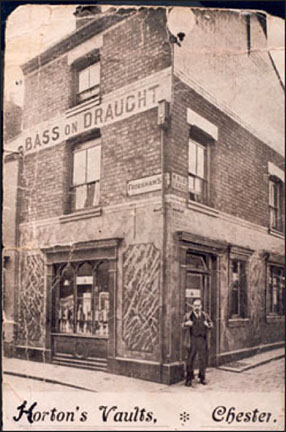 Horton's Vaults. Our photograph shows the pub, which stood on the corner of Frodsham Street and the Kaleyards. It closed in or before 1910 as we have a photograph from that year, showing a tobacconist / general store trading here- albeit with the large 'Bass of Draught' sign still in place. This evidently didn't last long, as we have another photograph from 1910 of a new, much more ornate building on the site housing Dutton's picture framers. They left in the 1990s and the place became a camping/outdoors shop. This in turn closed in 2011 and the handsome premises are, for the moment, home to yet another charity shop. We see the building above left, photographed by the author on a rather murky day in 2009. The sign of the still-thriving 18th century Oddfellow's Arms across the road may be seen on the far left hand side of the picture. Horton's Vaults. Our photograph shows the pub, which stood on the corner of Frodsham Street and the Kaleyards. It closed in or before 1910 as we have a photograph from that year, showing a tobacconist / general store trading here- albeit with the large 'Bass of Draught' sign still in place. This evidently didn't last long, as we have another photograph from 1910 of a new, much more ornate building on the site housing Dutton's picture framers. They left in the 1990s and the place became a camping/outdoors shop. This in turn closed in 2011 and the handsome premises are, for the moment, home to yet another charity shop. We see the building above left, photographed by the author on a rather murky day in 2009. The sign of the still-thriving 18th century Oddfellow's Arms across the road may be seen on the far left hand side of the picture.
Referring back to John Horton, his Great Great Grandson, Colin P Horton, wrote to tell us, "John Horton (1818-1893) became a Freeman of Chester in 1839 by right of birth. He was innkeeper of the Bull's Head Tavern, 58a Northgate Street, from 1851-71. He married his wife Hannah Jones in 1851. During his time at the Bull's Head he was in court three times for out of hours drinking- one occasion was serving liqour before hours on a Sunday, on another for refusing entry to a police officer after midnight. He had some brass neck in those days- the police station was under the Town Hall just around the corner from the pub.
He later moved to 63 Frodsham Street where he set up Horton's Vaults, which passed to his son upon his death the following year (my Great Grandfather, also John Horton). This John was also granted Freemanship of the City in 1874. April 1881 sees him marry Hannah Maria Robinson (Robinson's were timber merchants in Common Hall Street. I think that's where Tesco is now) Horton's Vaults was basically an of licencence, not a pub. As to ownership of the property I couldn't say for sure.
Unrelated in nature was my Grandfather Percy Victor Horton who was in the fish & chip business in lower Bridge Street & Sealand Road. Both shops are still in buiness, that in Lower Bridge Street is now a takeaway but Sealand Road remains a chippy.
The person in the photograph is thought to be Hugh Flood (Kelly's Directory 1896) who was Irish by birth and took over Horton's Vaults circa 1896. Note the electric street light on the corner of the building. Street lighting came to Chester the year he moved in, 1896. Hugh went on to run the Shrewsbury Arms (also in Frodsham Street- see below) with his sister. He died in 1933".
The Boatman's Arms Tavern, proprietor Robert Evans, appears in a Chester trades directory in 1840.
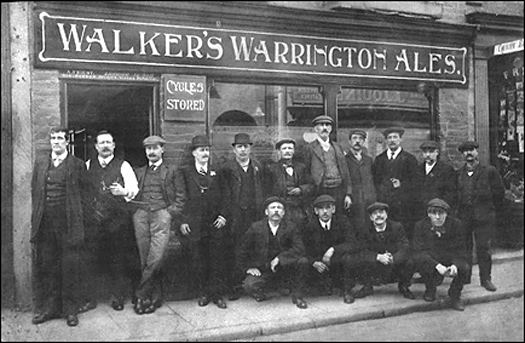 The Dairy Maid. Listed in the History, Gazetteer & Directory of Cheshire, 1850 when its licencee was James Howarth. Slater's Directory for 1855 has John Hayes in charge. The inn does not appear in the 1871 directory. The Dairy Maid. Listed in the History, Gazetteer & Directory of Cheshire, 1850 when its licencee was James Howarth. Slater's Directory for 1855 has John Hayes in charge. The inn does not appear in the 1871 directory.
Another Dairy Maid was in Francis Street.
The Red Lion Inn (no 45). Landlord in 1818-23 Thomas Dodd, in 1828 Jas. Bentley, in 1840 Edward Ellis (when it was listed as The Red Lion Tavern), in 1850-71 Mrs Jane Ellis, in 1880 Joseph Catherall, in 1902 William Ostle, in 1910 George W Walker and in 1911 Alfred Priest, who is pictured here, before the door of the Red Lion, accompanied by a few of his regulars..
There were other Red Lions in Lower Bridge Street and Handbridge- and yet another is still thriving in Northgate Street.
The Lord Raglan Inn (no 28/20). Licencee in 1857 D Davies, in 1880 John Henry Hawkins, in 1902 to at least 1910 Frederick Tilston Holland.
The Plough- recorded as being used as a polling station in 1809. Pigot's Directory 1818-20 records The Plough & Harrow, licencee Samuel Cooper,
The Lord Nelson - recorded as being used as a polling station in 1809.
The Three
Tuns Tavern (no 7). Landlord in 1840-55 John Jonas, in 1871 Henriette Tootell, in 1880 Joseph Bromley, in 1902 William Henry Clucas.
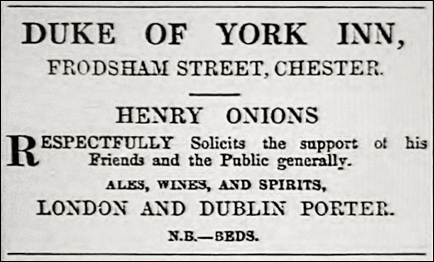 The Duke of York (no 2, next door to the Bear's Paw- see below). Licencee in 1818-1828 James Davies, in 1840-50 William Minshull, in 1855 Thomas Copeland, in 1857 R Denson, in 1871-80 Thomas Harper, in 1902 William Lewis. In 1906-10 William Higginson was the landlord. He had previously had The Muggeries in Northgate Street (later to become Quaintway's) then he moved on to The Castle Inn in Nicolas Street. This advertisment has the splendidly-named Henry Onions as licencee. We're unsure of its date at the moment.. The Duke of York (no 2, next door to the Bear's Paw- see below). Licencee in 1818-1828 James Davies, in 1840-50 William Minshull, in 1855 Thomas Copeland, in 1857 R Denson, in 1871-80 Thomas Harper, in 1902 William Lewis. In 1906-10 William Higginson was the landlord. He had previously had The Muggeries in Northgate Street (later to become Quaintway's) then he moved on to The Castle Inn in Nicolas Street. This advertisment has the splendidly-named Henry Onions as licencee. We're unsure of its date at the moment..
"Bart, a woman is like a beer. They look good, they smell good, and you'd step over your own mother just to get one". Homer Simpson
The Raven Inn (no 3)- a small seventeenth century inn that disappeared when the entire west side (the left, looking from Foregate Street) of the street was demolished for road widening between 1904 and 1912. Licencees, 1781-4 Thomas Fairclough, in 1785 Thomas Pinnington (Cowdroy's Directory, under the street's old name, Cow Lane), in 1822-28 John Rowe, 1840 John Radcliffe, 1846 Mary Radcliffe, 1850 Nathaniel Dyson, 1855-60 Joseph Mason, 1871-4 Frederick Green, 1880 Joseph C Harris, finally 1902-4 Samuel H Jennings. Used as a polling station in 1809.
After John Rowe senior (landlord of the Raven from 1790) died in 1830, his son John Rowe took over for a short time (the licence was actually in the name of his father’s executors James Rowe and A. Gamon). He advertised in the Chester Chronicle (19 September 1830):
"RAVEN INN, CHESTER. JOHN ROWE, (Son and successor of the late Mr. John Rowe) BEGS leave to return thanks to his numerous friends and the public for the support and patronage experienced for a long series of years by his late father, as TANNER, MALSTER and BREWER, and to announce that he has succeeded to the Business in each of those branches, in which he solicits a continuance of their favours.
Raven Inn, Chester, 10th Sept. 1830."
The Commercial Hall Tavern appears in Pigot's Directory for the years 1818-20 when the licencee was William Maylor (still there in 1822-3) and in Pughe's Directory for 1828/9 the licencee being John Griffith.
The Butcher's Arms - also appeared in the list of polling stations in 1809.
The Bricklayer's Arms. Listed in the History, Gazetteer & Directory of Cheshire, 1850 when Reginald Thomas was licencee.
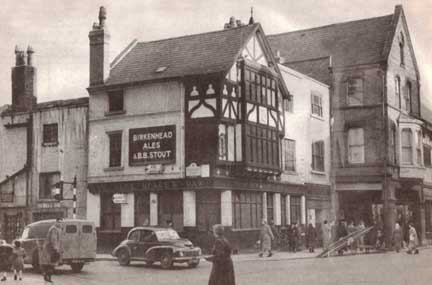 The City Arms (no. 32). According to Pigot's Directory, in 1818-28 the licencee was John Williams,in 1855 Henry Ellison, in 1857-71 S Hodgett Brookes, in 1880 John Hughes. Listed in the 1890 Kelly's Directory of Cheshire and the 1880 Slater's Directory when the licencee was William Wooliscroft. In 1914 George Jamieson was the landlord and in 1934 it was F Weston. This is the extant Temple Bar. The City Arms (no. 32). According to Pigot's Directory, in 1818-28 the licencee was John Williams,in 1855 Henry Ellison, in 1857-71 S Hodgett Brookes, in 1880 John Hughes. Listed in the 1890 Kelly's Directory of Cheshire and the 1880 Slater's Directory when the licencee was William Wooliscroft. In 1914 George Jamieson was the landlord and in 1934 it was F Weston. This is the extant Temple Bar.
Ye Olde Bear's Paw (no. 21, corner of Foregate and Frodsham Streets and next door to The Duke of York- see above.) The inn is illustrated left, just before its demolition in 1956. Landlord in 1818-20 John Lawson, in 1828 George Halley, 1840-50 Robert Bentley, in 1858 A Street, in 1880 John Taylor, in 1898 Fred Jones, in 1902-10 Edward Stanley Dawson, in 1914-20 John Frederick Davies.
This ancient establishment was demolished to make way for an exceedingly utilitarian building currently housing H Samuels' jeweller's
shop. According to the staff who work there today, it has managed to retain its ghost, 'George', however- no doubt a former regular of the vanished pub- and, indeed, the stock room on the first floor is known to them as 'George's Room'.
This is the junction of two major Roman roads- Watling Street, today's Foregate Street- running all the way to the English Channel- and Frodsham Street, which originated in the start of the road to Warrington and beyond, via Gorse Stacks, Brook Street, and the Newton Hollows (which Lucian the Monk called the 'Valley of Demons') in Hoole. Who knows how long there may have been some manner of tavern on the site.
After demolition, the licence- and name- was transferred to a new pub in Dickson's Drive, Newton and poor George was left behind. A much older picture of The Bear's Paw may be seem in our gallery.
"Keep your libraries, your penal institutions, your insane-asylums... give me beer. You think man needs rule, he needs beer. The world does not need morals, it needs beer... The souls of men have been fed with indigestibles, but the soul could make use of beer." Henry Miller
The Shrewsbury Arms. Reader Paul Parry recently wrote, "I am in need of a little more pub information. A certain Mary Fildes, the famous orator and Chartist injured at the Peterloo Massacre in Manchester (16th August, 1819), and also grandmother of Sir Luke Fildes the Victorian portrait painter, apparently ran two taverns in Chester during the mid 1800s. One being the Shrewsbury Arms in Frodsham Street, but this has since disappeared or has been renamed. The other tavern... I have no idea at all. I would like to know, if possible, where the Shrewsbury Arms was situated in Frodsham Street. The period she ran the taverns and if possible the name of the other tavern also".
Any ideas, dear readers? Click on Paul's name to email him directly- and we'd like to know more too. In July 2010, regular contributor 'ExChesterStudent' wrote concerning the above, "If you have a look through the 1857 directory below, you will find an M. Fildes who owned a "Wine & spirit merchant" at 28 Frodsham Street- http://cheshiredirectories.manuscripteye.com/book2.htm
At that time, it would have been next door but two to the present City Arms, as the City Arms was located at 32 Frodsham Street in 1857. There's no listing in the 1850 or 1868 directory for Mary Fildes.
There is one small (confusing) point. This person mentions that the Shrewsbury Arms that her ancestor owned was in Mickle Trafford (that particular Shrewsbury Arms is still there in Mickle Trafford under that name). My reckoning is that Mary Fildes did indeed manage 2 premises- the wine and spirit merchant at 28 Frodsham Street and the Shrewsbury Arms in Mickle Trafford. There are no other mentions / hints in any directories or any other official source of a Shrewsbury Arms ever being in Frodsham Street. However unlikely, she may have converted the wine and spirit merchant into an actual pub and called it Shrewsbury Arms for a short while. I don't know. The Shrewsbury Arms at Mickle Trafford was definitely around in that time period because it dates from at least the 18th century. See www.mickletrafford.org.uk/history.php. At that time in 1857, 28 Frodsham St would be where either the Pound Shop or Ethel Austin (if it was once 2 separate buildings) is now".
ExChesterStudent may doubt the presence of an inn of that name in Frodsham Street, but correspondent Colin P Horton told us, when discussing his Great Great Grandfather and Horton's Vaults (just down the road: see above), "Hugh Flood went on to run the Shrewsbury Arms with his sister".
Next door to The Shrewsbury Arms was The Ermine Vaults. Hilary Moore wrote to tell us that "a distant ancestor, Peter Moore was a baker and publican at the Ermine Vaults in Chester, given as 14 Frodsham Street in the 1871 census." Along with many other inns that once traded in Frodsham Street, it may be seen on this detail from the 1875 Chester OS map.
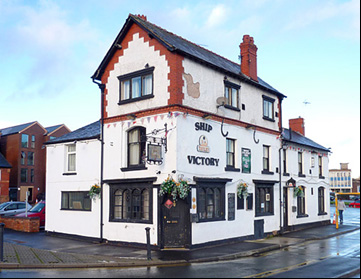 Woody: "How would a beer feel, Mr. Peterson?" Norm: "Pretty nervous if I was in the room." Norm from 'Cheers' Woody: "How would a beer feel, Mr. Peterson?" Norm: "Pretty nervous if I was in the room." Norm from 'Cheers'
George Street: The Ship Victory Inn (no. 47 George Street, corner of what was William Street. Illustrated right). This popular community pub closed, apparently for good, with the retirement of its longtime licencees Joe and Helen Gildea on New Year's Day 2014. Despite a spirited campaign to save it, and a great deal of objection, the pub was demolished in November 2015 in order to make way for a new bus station.
Its licencee in 1919-20 was J Cunnington. Its final licencee was Joe Gildea. See our new page about it in the gallery here..
The Shepherd's Arms (no. 87). Licencee in 1919-20 H Gosmore.
The Farmer's Arms was on the corner of George Street and Oulton Place.
The Drover's Arms was on the corner of George Street and White Alley, a narrow lane running alongside the Cattle Market. It may be seen in this detail from the 1875 Chester OS map.
The Ship was listed in the Post Office Directory of Cheshire in 1857 when the licencee was R Knowles.
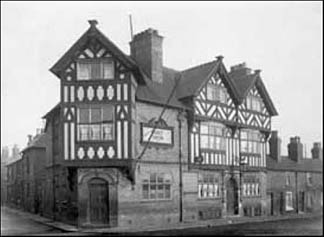 The Market Tavern (no 67, illustrated left). Reader Peter Wright then wrote to tell us, "It was in George Street, opposite the Cattle Market. To the left hand side of the pub was Thomas Street and about 50 yds to the right was Back Brook Street. The street that ran parallel to the back of the pub was Pitt Street, which was where I lived (No1) until February 1958, when our house was compulsory-purchased due to the forthcoming demolition of the street". The Market Tavern (no 67, illustrated left). Reader Peter Wright then wrote to tell us, "It was in George Street, opposite the Cattle Market. To the left hand side of the pub was Thomas Street and about 50 yds to the right was Back Brook Street. The street that ran parallel to the back of the pub was Pitt Street, which was where I lived (No1) until February 1958, when our house was compulsory-purchased due to the forthcoming demolition of the street".
In February 2008, Helen Sawyer wrote to tell us, "I loved the site listing the old pubs of Chester. I am currently researching my family tree and my great grandfather ran the Market Tavern in Chester with his wife Alice. Are you able to tell me where you found your information from, as I'd like to know which other pubs he ran in the area (I believe he also ran the Horse & Jockey in Ellesmere Port prior to this one), and when he left the Market Tavern. I understand that he was kicked out of the pub in the 1950s after some money was stolen from the till, but it would be good to tie this up a little more factually".
Thanks Helen. What was your relative's name? In 1910 to at least 1920 the licencee was Mrs Emma Turner, in 1934-5 J Pointer, in 1942 to at least 1952 Robert Stoddard McLarty. Some more interesting old photographs of the pub are in the gallery.
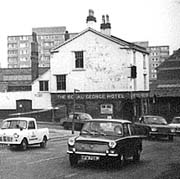 The Royal
George. (No 31, illustrated right). Landlord in 1880 David Jones, in 1902 John Dunbalin, in 1919-20 Mrs Dunbabin, in 1934 A L Catherall, in 1936 Leonard Catherall (same man?), in 1942 George Catherall. After him, during 1940s was Mr Thomas Shrives Evans, who died in the pub in 1952 (he had previous to this been licencee of the London Bridge Hotel in Lower bridge Street). His wife preceded him, having passed away on the premises in 1948. More pictures of the Royal George are in our gallery. Another view of it may be seen along
with some others of old George Street here). Its site is now a car park
opposite the recently-demolished Delamere Street bus station. The Royal
George. (No 31, illustrated right). Landlord in 1880 David Jones, in 1902 John Dunbalin, in 1919-20 Mrs Dunbabin, in 1934 A L Catherall, in 1936 Leonard Catherall (same man?), in 1942 George Catherall. After him, during 1940s was Mr Thomas Shrives Evans, who died in the pub in 1952 (he had previous to this been licencee of the London Bridge Hotel in Lower bridge Street). His wife preceded him, having passed away on the premises in 1948. More pictures of the Royal George are in our gallery. Another view of it may be seen along
with some others of old George Street here). Its site is now a car park
opposite the recently-demolished Delamere Street bus station.
Gloverstone: The Chester Courant in July 1752 advertised a house and shop to let in Gloverstone: "Any persons who are not free of the City of Chester cannot be hindered from following their trade in the said place as it is in the county. Apply to Elizabeth Brereton at the Royal Oak Inn at Gloverstone". This area was situated outside the gates of Chester Castle.
Goss Street: The Wellington Arms (no 18) is listed in the Chester Trades Directory for 1850 when the licencee was Ann Willams and in The Post Office Directory of Cheshire in 1856 when its licencee was David Parry. Slater's also has him there in 1855. Also referred to at one time as The Duke of Wellington- it was called this in 1855 when James Dickson was licencee (Slater's Directory).
In 1818 and 1828, Pigot's Directory called it The Wellington Tavern, landlord Joseph Fletcher, trading in "Goss-lane". John Fletcher, however, is recorded as being in charge in 1822-3. The inn is absent from the 1871 directory.
The Saddler's Arms traded in Goss Street in 1840 according to the Chester Trades Directory for that year. The licencee was Thomas Boulton.
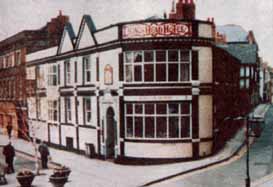 Grosvenor Street: (corner of Whitefriars) The King's Head Hotel (no 2, illustrated left) sadly closed and demolished in 1986. The site of this handsome building is now occupied by Jessop's
camera shop and insurance offices within a 'Tudor Lego-style' development by the name of 'Friarsgate'. Grosvenor Street: (corner of Whitefriars) The King's Head Hotel (no 2, illustrated left) sadly closed and demolished in 1986. The site of this handsome building is now occupied by Jessop's
camera shop and insurance offices within a 'Tudor Lego-style' development by the name of 'Friarsgate'.
Some more pictures of it may be seen in our gallery. Listed in Pigot's Directory for 1818-20 when the licencee was William Roberts. The licencee in 1840 (when the house was also listed as a coaching office) was Thomas Onslow, in 1850 John Roberts, in 1857 P J Bedson, in 1880 John Parry, in 1902 Thomas Bridge, in 1910 John Sampey, in 1914 to at least 1920 Alexander McLean, in 1934-5 W Dodsworth, in 1936 S F Gaunt, in the early 1970s Jack Blackwell (see below).
The King's Head- or an earlier inn on its site- was previously called The White Horse, and prior to that was called The Horse and Baggs.
In November 2007, Graham Blackwell wrote to us, "My uncle Jack Blackwell was the landlord of the King's Head Hotel, which must have been around the early 1970s. He was well known in publican circles around Chester and I remember after his funeral, when licensing hours meant closing at 3pm, that all attendees were cordially invited to spend the afternoon in a variety of establishments all over town! I think it ended in the sadly demised Commercial. Jack's last 'post' was running the bar at the Gateway Theatre. Since embarking on family history and knowing nothing about my own family (and sadly now no-one to ask!) I have often wondered how many other establishments Jack had been involved in. I know he got the sack from many due to his liking for the drink. Nothing to do with Chester I know but the list also includes Hawkstone Park Hotel in Shropshire, the Equestrian Club in Raby Mere and hotels in Blackpool and the Isle of Man! I think I have some of his genes!"
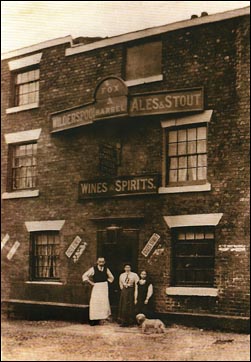 In October 2012, the Chester artist Jill Pears told us, "I remember it being one big room with the bar to the left as you went in and a big corner room upstairs. This was in the early 1980s at the time of the New Romantic era, when all the girls were going round wearing pirate shirts". In October 2012, the Chester artist Jill Pears told us, "I remember it being one big room with the bar to the left as you went in and a big corner room upstairs. This was in the early 1980s at the time of the New Romantic era, when all the girls were going round wearing pirate shirts".
Brooksbanks Wine Merchants were situated on the corner of Grosvenor Street and Lower Bridge Street until they were demolished in 1961 to make way for the Inner Ring Road. A special feature about the Brooksbanks business, with some fascinating photographs by Keith Rhodes and Chris Langford, is here.
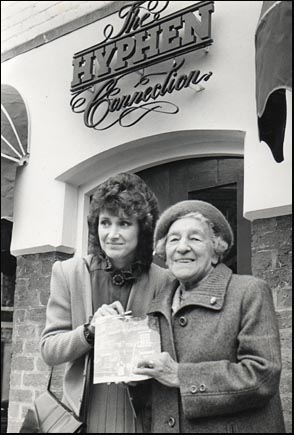 Kelly's Directory for 1902 lists a Belgrave Vaults trading at 14 Grosvenor Street and 2 Cuppin Street when J Brown was the licencee. Kelly's Directory for 1902 lists a Belgrave Vaults trading at 14 Grosvenor Street and 2 Cuppin Street when J Brown was the licencee.
Also listed in the 1902 edition is The Fox & Barrel at no 16 Grosvenor Street, whose licencee at the time was Mrs Elizabeth Jones. In 1850 it had been George Harrison and from 1857 to at least 1880 it was Thomas Worby. Thomas Miley had it until 1914, when he moved to The Red Lion on the corner of Pepper Street and Lower Bridge Street. Kelly's Directory shows him here in 1910. The building housed a Brazilian restaurant for a while but, at the time of this latest update, Ausgust 2017, had been vacant for quite some time and awaiting new tenants..
The photograph on the right was taken in the 1970s and shows the then-popular newsreader Jan Leaming at the opening of a new fitted kitchen business, The Hyphen Connection in the much-altered former premises of the Fox & Barrel. Previous to this, the building had been home to a scooter dealership, Autospeed. The cheery elderly lady standing with Ms Leaming is Annie Margaret Miley (nee Sims) whose father was Thomas Miley. She is holding a photograph of her dad (reproduced on the left) standing outside the old pub.
As previously mentioned, after leaving The Fox & Barrel, he became the longtime landlord of The Red Lion on the corner of Bridge Street and Pepper Street.
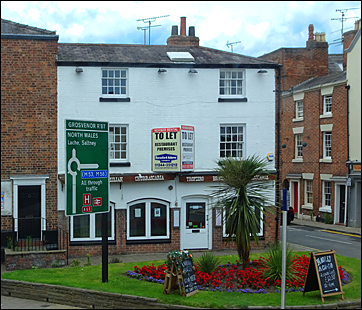 The 1871 census lists The Comberman Vaults trading in Grosvenor Street. The 1871 census lists The Comberman Vaults trading in Grosvenor Street.
The Westminster Tavern traded in Grosvenor Street in 1840, licencee Anne Moss.
The Saddle Inn, 21
Grosvenor Street, traded under that name for more than a century before
changing to The Chester Bells in 1996. In 1850 its licencee was Thomas Taylor, in 1855 Mary Davies, in 1857 J Griffith, in 1871 Reubon Smith, in 1880 A. Bernhardt, in 1910-1914 Charles C Edwards, in 1934 Harry Hopwood.
In 2016 the pub reverted back to its old name and continues to thrive today as a 'rock' venue.
Left: the old Fox & barrel in August 2017
The Groves: In the 1840 directory it is recorded that a Mr John Walls was licensee of The Groves Tavern. Originally built in the early 18th century, Groves House had originally been the home of a Recorder of Chester, Roger Comberback, who died in 1719. Richard Tyrwhitt, a later Recorder, took the tenancy of Groves House in 1820. It became an inn by the name of The Queen's Park Hotel soon after he vacated it in 1830, its name later changing to The Groves Tavern. The building of the suspension bridge in 1852, when Enoch Gerrard developed the Queen's Park residential area across the river, resulted in the "curtailing" of the inn. It had apparently ceased to function as such when its remainder was obliterated when the still-surviving houses next to the bridge were built.
During the years 1873/7 licensing records show a beer-house trading under the name The Causeway Tavern, licencee Mr John Moor Ainsworth. It is recorded that the owner was "The Lord Bishop". No known records of the pub exist after 1877. Another Causeway Tavern was listed in the 1871 census trading in Newgate Street (see below)..
Slater's Directory records The Deva Hotel trading on the Groves in 1855, licencees John & Joseph Huxlie.
The trades directory for 1840 lists Sarah Aikman trading as 'florist and beer house' on The Groves.
A commemorative pamphlet issued at the time of Chester's 'River Carnival' in 1977 contained an advertisment for the splendidly-entitled Halt-a-While Licensed Cafe. Can anybody remember this and where on The Groves it was located?
"Who does not love beer, wine, women and song remains a fool his whole life long." Carl Worner
Hamilton Place: The Duke of Wellington. Listed in Slater's Directory 1880 when the licencee was Harriet Duckers.
Handbridge: The White Horse Inn (no 66- but, as numbering was, to say the least, somewhat erratic in Handbridge, also recorded as varying from 60 to 64 and 68), was closed down for some time but, after a radical makeover, re-opened in April 2008 with an unimaginative new name, 'Handbridge'. In 1822-3 the licencee was Ann Hewitt. A long-serving landlady of the same name also had the Horse & Groom in Handbridge (see next entry) at the same time- the same lady? In 1828-40 Charles Hignett was the proprietor (listed in 1840 as "blacksmith and White Horse Tavern"), in 1850 Joseph Pennington, in 1855 Edward Williams, in 1857 J Cuthbert, in 1871 John Thrash, in 1910-1914 J C Simmonds. The Simmonds family were in residence from around 1906 to 1930. In 1935 it was James Burgess.There was another White Horse trading in Boughton.
In July 2007, 'Trish' wrote to tell us "the Innkeeper of The White Horse in 1851 was Thomas Bentley, my great, great grandfather, and I've found a descendant of his in Australia who is delighted that I've been to the pub and sent photos to her. Thanks again, Trish".
 The Horse & Groom- existed in 1752 when the creditors of a bankrupt cheese merchant met there. The landlord at the time was Thomas Worsley. In 1782 the licencee was Ann Hewitt. A licencee of the same name was recorded in Pigot's Directory as being there in 1818. In 1822-3 the landlady was- you guessed it- Ann Hewitt! The same landlady in charge for over forty years? The Horse & Groom- existed in 1752 when the creditors of a bankrupt cheese merchant met there. The landlord at the time was Thomas Worsley. In 1782 the licencee was Ann Hewitt. A licencee of the same name was recorded in Pigot's Directory as being there in 1818. In 1822-3 the landlady was- you guessed it- Ann Hewitt! The same landlady in charge for over forty years?
The White House is listed in a Cheshire directory in 1880 when the licencee was John Thrash. Another White House long existed on Dee Banks, close the still-extant Red House.
The Angel- existed in 1791, landlord T. McCabe.
The Harp- existed in 1781, landlord George Sconce.
The Duke of Wellington (no. 31) was demolished 1928 to make way for new shops, the first occupant of which was H K Crossland's grocers. Today its site is occupied by Martin's Newsagents. Landlord in 1818-22 (when it was called The Wellington Tavern) was George Lloyd, in 1822 James Davies, in 1828 (listed in Pigot's Directory as The Lord Wellington) George Lloyd had returned, in 1840-71 (from when it was listed as The Wellington Inn) James B Jones, in 1897 John Jones (when it was still The Wellington Inn), in 1880 Edward Jones, in 1900-28, William Hanmer.
The press cutting on the right, recording a spot of bother for newly-arrived licencee John Jones, appeared in the police court section of the Chester Courant, 22nd September 1897.
The Eagle & Child- landlord 1782 John Liversage, in 1818-20 John Iverson, in 1822-3 John Liversage (again? perhaps a directory mistake), in 1828 Thomas Gibson. In 1811, an announcement appeared in the Chester Courant advertising the sale by auction of grass in the "Governor's Field" at Mrs Hughes' Eagle & Child. This meadow is now the modern extension to Overleigh Cemetery.
The Fox or Fox & Grapes- landlord in 1779 Marther Hayes, in 1781 Richard Hayes, in 1818-20 (when Pigot's Directory listed it as The Fox) John Gill, in 1822 (still The Fox) Edward Price.
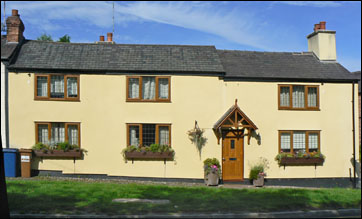 The Hare and Hounds Tavern (illustrated left and below) was remarkable for its variations of address- 149 and 117 Handbridge, Old Wrexham Road and 51 & 81 Overleigh Road. The landlord in 1781 was John Morgan, in 1818-28 Edward Phillips, in 1840 Thomas Jones, in 1850 Edward Neild, in 1857 T Jones, in 1880 Edward Blacow, in 1919-20 John Hanmer. The Hare and Hounds Tavern (illustrated left and below) was remarkable for its variations of address- 149 and 117 Handbridge, Old Wrexham Road and 51 & 81 Overleigh Road. The landlord in 1781 was John Morgan, in 1818-28 Edward Phillips, in 1840 Thomas Jones, in 1850 Edward Neild, in 1857 T Jones, in 1880 Edward Blacow, in 1919-20 John Hanmer.
In July 2012, Graham Whitley wrote to tell us that "the census of 1881 shows my great grandfather William Whitley, aged 44, living at the Hare and Hounds as Innkeeper, with his wife Jane 44 and four children, Charles 13, my grandfather Albert Edward 9, Sarah 6 and William 4. I was delighted to meet the current owners recently and the building has been beautifully renovated".
Apart from the smart coat of paint, the only external alteration is that the front door has been moved slightly to the right, where the hanging basket now is.
We're grateful to Graham and his wife Linda for the information and also for contributing these fine photographs. Larger versions may be seen in our Lost Pubs Gallery.
The licencee in
1902 was Thomas Edward Griffith, and from 1910 to its closure, when the licence was withdrawn in 1922, John Hanmer. He was the brother of William Hanmer, landlord of the Duke of Wellington.
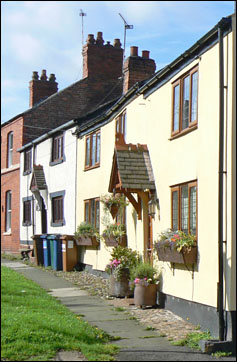 The King's Arms stood next door to the Hare &Hounds- the white house in this photograph. Its landlord in 1818-28 was James Murphy, in 1840 Daniel Davies, in 1871 Hiam Ives, in 1880 Thomas P Garrett, in 1902 Mrs Betsy Speed, in 1910 Joseph Speed, in 1919 to at least 1920 "Mrs Speed". The Speed Family were licencees for the last 30 years of its existence. It closed in 1922 (this seems to have been a year of mass extinction for Handbridge pubs). The King's Arms stood next door to the Hare &Hounds- the white house in this photograph. Its landlord in 1818-28 was James Murphy, in 1840 Daniel Davies, in 1871 Hiam Ives, in 1880 Thomas P Garrett, in 1902 Mrs Betsy Speed, in 1910 Joseph Speed, in 1919 to at least 1920 "Mrs Speed". The Speed Family were licencees for the last 30 years of its existence. It closed in 1922 (this seems to have been a year of mass extinction for Handbridge pubs).
The Hare & Hounds and The King's Arms stood next door to each other on the corner of Old Wrexham Road and Overleigh Road, the Hare & Hounds being on the very corner and the King's Arms standing next to it. You can still see them today as they were both converted into private residences.
Around 1902, licencing magistrates were empowered to close premises which they regarded as redundant and the Handbridge committee proposed to do just that to the two adjoining old pubs in Old Wrexham Road. To save her business, Mrs Speed, the landlady of the King's Arms, engaged a Birkenhead solicitor who had a reputation for winning similar cases. He succeeded here too, enabling the King's to remain open for another couple of decades until once again, it was declared redundant. This time the landlady declined to contest the decision. When asked why, she replied that she was unwilling to trust anyone but her former advocate but had been unable to engage his services- which was hardly surprising, as he had since been elevated to the title of Lord Birkenhead, the Lord Chancellor.
The Feathers (no. 146- Hugh Street today), landlord 1840-82 George Edwards.
The Feathers was mentioned in the Cheshire Observer in August 1886 where its owner was given as the Duke of Westminster.
Fifty years earlier, one Henry Allman was baptised on the 30th April 1836 at St Bridge's Church in Chester. His parents were John and Anne Allman. John's occupation was recorded as hostler (or ostler)- "a groom or stableman, who is employed in a stable to take care of horses, usually at an inn"- at the Feathers in Handbridge.
The Greyhound Inn appears in the Post Office Directory of Cheshire in 1857 when the licencee was T Moore. Another Greyhound Inn continues to thrive today in the village of Saughall.
The Coach & Horses (no. 17), landlord in 1778 William Ball, in 1809 Daniel Gibson, in 1818-20 G Williams, in 1822-3 J Williams, in 1828 Joseph Sadler, in 1840 John Jones, in 1850 Elizabeth Jones, in 1871 George Edwards, in 1880 Robert Webb, in 1895 T Richards, in 1902 Mrs H Webb, in 1910 Mrs M Moore, in 1920 John Patten. The licence was withdrawn in 1922.
The Handbridge Tavern. Listed in Pigot's Directory for 1828/9 when the licencee was Samuel Hughes.
The Cottage Tavern. Listed in Pigot's Directory for 1828/9 when the licencee was William Grice.
The Cock Tavern. Listed in Pigot's Directory for 1828/9 when the licencee was William Davies.
The Waterloo Inn (no. 20) Landlord in 1818-20 William Nicolls, in 1822 J Jones, in 1840 Joseph Greenway (origin of Greenway Street?), in 1850 Joseph Ridgeway, in 1855 James Bevin, in 1871-80 Elizabeth Hooley, in 1902-1910 William Blackmore, in 1914 to at least 1920 Frederick Lane. It closed c.1922, since when it has been utilised as a bakery, a clothes shop, an antiques business a hat shop and other retail purposes.
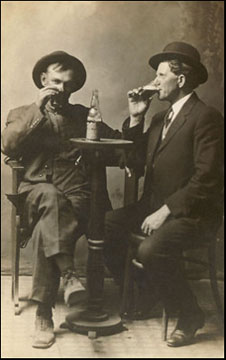 The Old House at Home- also known as The Maypole- situated at junction of Eaton Rd and Overleigh Rd, landlord in 1782 George Lloyd, in 1822 Thomas Williams, in 1850Samuel Crosbie, in 1855 Thomas Jackson. The Old House at Home- also known as The Maypole- situated at junction of Eaton Rd and Overleigh Rd, landlord in 1782 George Lloyd, in 1822 Thomas Williams, in 1850Samuel Crosbie, in 1855 Thomas Jackson.
"A good pub has much in common with a church, except that a pub is warmer, and there's more conversation". William Blake
The Wheatsheaf Tavern (no. 23)- last appeared in trade directories as a pub in 1905. By 1906 it had changed to a newsagents owned by a Mr E Dawson (Thanks to Godfrey Dawson, his Grandson, for this one). In 1828 the licencee was Patrick Kelly, in 1840 John Hughes. In 1855 Slater's lists the inn but omits the licencee's name. In 1871 it was Thomas Culmn and in 1880 Peter M Evans. Other pubs by the name of Wheatsheaf or Wheat Sheaf were in Watergate Street and Boughton.
The Lamb Inn- also known at various times as the Handbridge Hotel and Scott's Hotel- situated by the entrance to the mean courts known as 'Paradise'. Landlord 1812-29 Joseph Scott (although Pigot's Directory gives Mary Scott as licencee between 1818 and 1820), 1840 James Clerk. Its licence was withdrawn before 1863.
The White Lion (No. 60) Landlord in 1781 J Jackson.
The historic Ship Inn (no 18 Handbridge) at the end of the Old Dee Bridge long remained shamefully empty and boarded up but has recently undergone a fantastic restoration under its new owners Davin and Sally Harris, who reopened the place at the end of April 2009- the old Ship is afloat once more! The Ship's licence can be traced back to 1741when the landlord was a Mr Walley. In 1770 the licencee was Stephen Hyde, in 1771 to at least 1789 (when he appears in Cowdroy's Directory) John Bannister. He was fined in 1784 for selling short measures. By 1792 Mrs Bannister was in charge, in 1812 Thomas Griffiths, in 134 James Clare, in 1828 Mary Davies, in 1840 James Duff, in 1846-57 William Dutton, in 1869-80 Alexander Richardson, in 1882 Horne Richardson, in 1902 to at least 1910 Robert Herbert Higginson, in 1913 the Gray Family, who ran the pub for seventy years, until 1983; Robert Edward Gray was there in 1914 - 1934, in 1946 A Gray.
A commemorative pamphlet issued at the time of Chester's 'River Carnival' in 1977 contained the following curious advertisment, "At the Ship Inn, Handbridge. Gray's Pottery, a "small concern run entirely by the Gray family (Reg, Christina, Christopher and Wendy)... Our pottery has been well received throughout the world."
Certainly an interesting sideline to the licenced trade, about which we'd love to know more. Can anybody help?
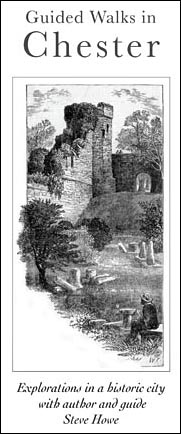 Norman Wakefield took over in 1983, A Tatler in 1994 and A Phelps in 1997. The last licencee before closure was Pat Wilbraham and the first after re-opening Davin and Sally Harris. During the period 1850-60, the licencee, Mr William Dutton, was a man of many talents, for as well as landlord he was also a practicing blacksmith, farrier and wheelwright. The Ship was a true waterside hostelry whose neighbours included manufacturers of twine and rope for fishing nets. It had a new frontage added in 1925. As early as 1441, a record of an 'ale hous' on the same site tells of a brawl taking place over a lady of doubtful reputation. The men involved were fined 1s 6d each for disturbing the peace but the 'lady' was confined in a house of correction for 7 days. Norman Wakefield took over in 1983, A Tatler in 1994 and A Phelps in 1997. The last licencee before closure was Pat Wilbraham and the first after re-opening Davin and Sally Harris. During the period 1850-60, the licencee, Mr William Dutton, was a man of many talents, for as well as landlord he was also a practicing blacksmith, farrier and wheelwright. The Ship was a true waterside hostelry whose neighbours included manufacturers of twine and rope for fishing nets. It had a new frontage added in 1925. As early as 1441, a record of an 'ale hous' on the same site tells of a brawl taking place over a lady of doubtful reputation. The men involved were fined 1s 6d each for disturbing the peace but the 'lady' was confined in a house of correction for 7 days.
Another pub, The Dolphin, landlord J South, is recorded as existing in 1781 located "at the south end of the Old Dee Bridge".
Currently, the only pubs left in Handbridge are The Grosvenor Arms (no. 32), The Red Lion (closed for a while but restored and re-opened in 2007), The Carlton Tavern the former White Horse, also closed for a while but now re-opened bearing the new name, Handbridge- and now again The Ship.
In 1822-28 the licencee of The Grosvenor Arms was Robert Sinclair, in 1840 Thomas Tollough, in 1850 Margaret Williams (another directory, however, says William Dutton). In 1855 to around 1890, the Joinson family were the licencees, giving their name to Joinson's Court, which adjoins the pub. in 1910 to at least 1920 William B Clubbe, in 1934-5 Mrs E Clubbe. The Clubbe family ran the Grosvenor for over forty years and their name has become permanently attached to the place, universally and fondly known as it is as Clubbbie's.
The site of The Carlton Tavern was formerly occupied by The Carlton Hotel (licencee Mary Tompkinson) at no.1 Hartington Street, E Powell, grocers at no.3 and an adjoining cottage, no.5. These all vanished when the Carlton was built in the 1920s- and explains why the house next door to it remains as no.7. The licencee in 1934-5 was L J Holland.
Returning to the Red Lion, located at 37 Overleigh Road, we recently received this appeal from Barbara Winterton in St. Gelven, Brittany: "I'll explain why I was asking about The Red Lion in Handbridge. Many years ago my great aunt lived there with Em Humphries who was the landlady. I remember visiting them with my grandfather with whom I lived. I think that when Em Humphries died in the 1960s or 1970s that she was the oldest landlady in Chester as she was 92. I also think that she was a family member but don't know where she fits in. There was some scandal about her having an illegitimate child but again I have no further information. I would love to be able to place her in the family and suspect that she was the step daughter of Joseph Evans of the Elephant & Castle (in Eastgate Street) although her name would have been Williams. I purchased a copy of Joseph's will in the hopes that he had actually been landlord at the Red Lion and that Em had taken over later. I tried to find out who was in the Red Lion in 1901 but have failed using the Internet and no one can tell me how to find out any other way. If any of your informants have any info on Em I would be most grateful".
You can contact Barbara by email or phone: ++33 (0) 2 96 36 97 31.
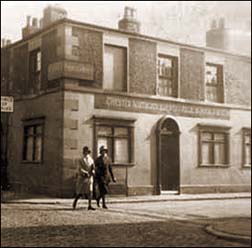 The Red Lion was first licenced in 1781. The licencee in 1822-3 was Thomas Williams, in 1855 Margaret Williams, in 1828-40 Timothy Williams, in 1857 Mrs M Williams, in 1910 Mrs Emily Maria Humphries. The building we know today was erected in 1912 when Mrs Humphries was licencee. When she died, aged 71, the licence passed to her daughter, Miss Emily Humphries, affectionately known to all as "Miss Em". She became famous as Chester's oldest licencee, pulling pints for well over fifty years until she died in 1971, aged 93. Miss Em's spirit is reputed to haunt the pub today, remembering a time when a pint cost threepence ha'penny and a scotch
tupppence.. The Red Lion was first licenced in 1781. The licencee in 1822-3 was Thomas Williams, in 1855 Margaret Williams, in 1828-40 Timothy Williams, in 1857 Mrs M Williams, in 1910 Mrs Emily Maria Humphries. The building we know today was erected in 1912 when Mrs Humphries was licencee. When she died, aged 71, the licence passed to her daughter, Miss Emily Humphries, affectionately known to all as "Miss Em". She became famous as Chester's oldest licencee, pulling pints for well over fifty years until she died in 1971, aged 93. Miss Em's spirit is reputed to haunt the pub today, remembering a time when a pint cost threepence ha'penny and a scotch
tupppence..
"It is my design to die in the brew-house;
let ale be placed to my mouth when I am expiring,
that when the choirs of angels come,
they may say, "Be God propitious to this drinker." Saint Columbanus AD 612
Henry Street: The Prince of Wales (no 1, illustrated right and below). Licencee in 1934 F Williams.
Demolished to make way for high-rise flats.
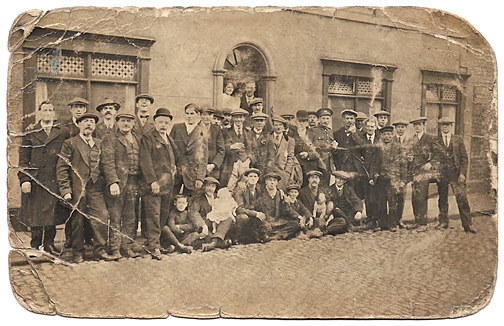 Hoole: The Ermine Hotel on Hoole Road has been in business since at least the 18th century- and probably much earlier. It was once the last stage coach watering stop before Chester on the old Warrington road. It closed in February 2004 but re-opened the following July with a new name- The Flookersbrook (after the name of the neighbourhood, from an ancient stream that continues to run nearby, albeit culverted beneath the road). After an encouraging start, however, the decent beer vanished and the place has become an occasional 'rock' venue bearing
the alternative signage of 'Brooker's Bar'.
In 2012, the popular Chester Beer Project rated the Flookersbrook as "one of the ten worst pubs in Chester": Hoole: The Ermine Hotel on Hoole Road has been in business since at least the 18th century- and probably much earlier. It was once the last stage coach watering stop before Chester on the old Warrington road. It closed in February 2004 but re-opened the following July with a new name- The Flookersbrook (after the name of the neighbourhood, from an ancient stream that continues to run nearby, albeit culverted beneath the road). After an encouraging start, however, the decent beer vanished and the place has become an occasional 'rock' venue bearing
the alternative signage of 'Brooker's Bar'.
In 2012, the popular Chester Beer Project rated the Flookersbrook as "one of the ten worst pubs in Chester":
"Hoole has become one of the more affluent parts of the city and this big pub should have been able to capitalise on that. The huge success of ‘the Lodge’ just along the road [our home from home], proves that there was a demand for a smart modern boozer in the vicinity, serving quality beverages. However, this place is none of those things and I doubt it ever will be. The ale is vile and the interior is cavernous and characterless. Can’t think of a single reason why anyone would want to drink in here, unless of course they’d been barred from everywhere else".
Advertisement from Adams’s Weekly Courant, 18 July 1780:
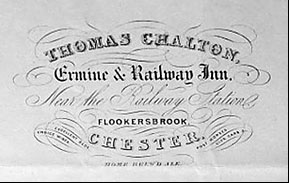 MARY ARTINGSTALL, of FLOOKERSBROOK, near this City, Begs leave to inform the Friends of her late Husband, John Artingstall, deceased, THAT she intends to continue the PUBLIC BUSINESS, as usual, at the Sign of the Ermine, in Flookersbrook aforesaid; and also to carry on the MAKING of MALT, under the Management of the Person employed by her late Husband, to whose Friends she returns her sincere Thanks; and assures them and the Public in general, that those who will please to favour her with their Commands, shall be served with the above Article upon the best and most reasonable Terms, MARY ARTINGSTALL, of FLOOKERSBROOK, near this City, Begs leave to inform the Friends of her late Husband, John Artingstall, deceased, THAT she intends to continue the PUBLIC BUSINESS, as usual, at the Sign of the Ermine, in Flookersbrook aforesaid; and also to carry on the MAKING of MALT, under the Management of the Person employed by her late Husband, to whose Friends she returns her sincere Thanks; and assures them and the Public in general, that those who will please to favour her with their Commands, shall be served with the above Article upon the best and most reasonable Terms,
By their oblig’d and faithful Servant,
MARY ARTINGSTALL
In 1818-20, The Ermine's licencee was John Lightfoot (there is a Lightfoot Street just across the road from the pub today), in 1822-3 W Monk, in 1828 Isaac Spedding, in 1840 Isaac David Jacques (who enlarged the place and added the bowling green), later in the 1840s (when it was called The Ermine and Railway Inn) Thomas Chalton, in 1857 C Fern, in 1880 Alexander Kelly, from 1902 to at least 1914 Mr George Barnes and in 1934 Mrs Alice L Wedgwood. You can read some more fascinating 18th and 19th century advertisments for the Ermine on our brief photographic history of the pub. As with the rest of the site, your contributions and reminisciences are ugently sought and greatly appreciated!
Pigot's Directory for the years 1818-20 lists The Bowling Green as trading in Flooker's Brook, landlord J Bennett. This was the Bowling Green Inn on the corner of Brook Street and Milton Street, today's Catholic Social Club. It's worth noting that Brook Street was sometimes classed as "Flookersbrook" in the first half of the 19th century and beyond.
Today, we consider it merely the area immediately around the Flookersbrook pub- the old Ermine Hotel.
 The Beehive Hotel, 15 Hoole Road (left)
closed as recently as the Spring of 2011 and has become a branch of audio/video retailers Richer Sounds- who moved here from another of Chester's 'lost pubs', The George on the other side of Hoole Bridge. Sad really, the Beehive may have been a shocking dump at the end but the loss of yet another of Chester's venerable inns is still a tragedy; the place could have been a little goldmine in the right hands. Ironic, too, that the newly-painted building looks better than it has in years. The Beehive Hotel, 15 Hoole Road (left)
closed as recently as the Spring of 2011 and has become a branch of audio/video retailers Richer Sounds- who moved here from another of Chester's 'lost pubs', The George on the other side of Hoole Bridge. Sad really, the Beehive may have been a shocking dump at the end but the loss of yet another of Chester's venerable inns is still a tragedy; the place could have been a little goldmine in the right hands. Ironic, too, that the newly-painted building looks better than it has in years.
In 1892-6, when it was called The Bee Hive Hotel, the licencee was W J Armstrong, in 1902 James Enest Galt, in 1919-30 George A Jones, in 1942 Mrs Martha Florence Earie.
In December 1921, Fred Lowe wrote in the pages of the Cheshire Sheaf- part of his reminiscience of Hoole in former times- "On the opposite side of the road... was a small public-house called the "Bee Hive." This house some years previously was called "Help Me Through." On the front part of the house was a painted sign, shewing a man struggling halfway through a large globe representing the world. The house stood close to the footpath and directly in front of the present spacious "Bee Hive" Hotel. There was, I believe, another version of the origin of the quaint inn sign". The Beehive now has its own page in our Lost Pubs Gallery..
Pigot's Directory 1818-20 mentions The Cottage Tavern trading in Flooker's Brook, licencee J Davies. There is still a Cottage pub in Brook Street; was this the same one and was Brook Street counted then as being in Flookersbrook?
The Directory of Licenced Houses for the year 1891 contains several entries for The Letters which, curiously, is listed as being both on Walker Street and at 70 Peploe Street (the former name of today's Westminster Road) Even more confusingly, its owners are listed as,
1) the Wilderspool Brewery, Warrington (licencee Charles R Harrison),
2) Mr A Pritchard, Solicitor of Chester (licencee John Payne, lessee Walker & Co, Warington),
3) William Wood of Hoole (licencee Benjamin Jones, lessee Lion Brewery Co, Chester),
4) Robert C Drury
of Chester (licencee William Mullins, lessee Walker & Co, Warringon).
The premises is described as "beerhouse, on and off sales" except under the latter's entry where it is described as "off sales only."
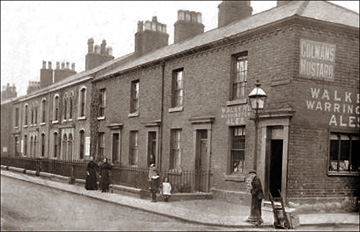
Quite a few more "beer retailers"- off-licences- appear in the old Hoole trades directories. In 1878, Mrs Rebecca Hughes traded at 8 Faulkner Street. Fourteen years later, 1892, Charles Roberts was at the same address. In the same year, John Payne sold beer from 19 Peploe Street and John Benjamin from 46. In 1914, George Dutton ran an off licence at 138 Westminster Road and Albert Harrison was there in 1939. William Roberts had one at 19 Peploe Street (now 31 Westminster Road on the corner of Charles Street: illustrated right) and it was still going in 1939 when Archibald Manley ran it.
The place continued as an off licence until just a few years ago, under the name Victoria Wine, but is currently a cafe and bread & cake retailer.
The jolly-sounding Merry Trees Beer House was recorded as trading in "Flooker's Brook" in 1840, licencee Richard Peers.
We received this interesting letter recently from Greg Howard in far away Brisbane, Australia:
"I came across your excellent 'Chester's Vanished Inns Pubs and Breweries' and venture to ask if you might be able to shed any light on references to an early 1800s inn that I have been unable to locate?
A disreputable ancestor of mine, Thomas Broom, was convicted in Chester in 1830 and transported to New South Wales for life. The crime- “stealing from the person”- took place at an inn in Chester. One of the newspaper articles I found (Chester Chronicle 10th July 1829) refers to "The Wheelwright's Arms public house in Flookersbrook", while another article (Chester Chronicle 17th Sep 1830) refers to "the Wheelwright's Arms, in Egerton Street." Both are in accounts of the robbery that resulted in my ancestor's conviction and transportation. Basically, he and three others befriended a wealthy 70-year old farmer at the Chester Fair, went to the inn with him, slipped some laudanum into his drink, and removed about 60 pounds from his waistcoat. Two were arrested near the scene but Thomas Broom evaded capture for a year. All were transported for life. I should say in his defence that he seems to have lived an exemplary life in Australia. Wondering if you might be able to help with identifying this old inn?"
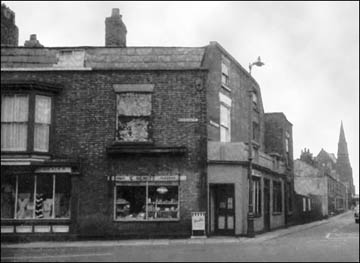 Today, a number of venerable pubs (albeit often much-altered) continue to thrive in Hoole; remarkably, unlike the rest of the city- and country for that matter- there have been no closures in living memory- The Royal Oak, The Bromfield Arms and The Faulkner in Faulkner Street, and The Flookersbrook (the venerable Ermine Hotel) on Hoole Road. In addition, there is the large pub/restaurant, The Oaklands (once a grand private house)- now part of the Hungry Horse chain- on Hoole Road and a number of bars situated in the private hotels that proliferate in the area. The most recent of these- and your guide's local- is the excellent Lodge Bar in the Bawn Lodge Hotel on Hoole Road. As for off-licences, there are almost too many to count. Many are listed in our Hoole Business Directory. Today, a number of venerable pubs (albeit often much-altered) continue to thrive in Hoole; remarkably, unlike the rest of the city- and country for that matter- there have been no closures in living memory- The Royal Oak, The Bromfield Arms and The Faulkner in Faulkner Street, and The Flookersbrook (the venerable Ermine Hotel) on Hoole Road. In addition, there is the large pub/restaurant, The Oaklands (once a grand private house)- now part of the Hungry Horse chain- on Hoole Road and a number of bars situated in the private hotels that proliferate in the area. The most recent of these- and your guide's local- is the excellent Lodge Bar in the Bawn Lodge Hotel on Hoole Road. As for off-licences, there are almost too many to count. Many are listed in our Hoole Business Directory.
“God made yeast, as well as dough, and he loves fermentation just as dearly as he loves vegetation." Ralph Waldo Emerson
Hunter Street: The Doric Hotel.
The Crown and Mitre
Lyon Street: The Liverpool Arms stood at the junction of Lyon Street, Wellington Street and Brook Place, Newtown. It is shown on a map of 1870 but, for the moment, we know nothing more about it.
Leadworks Lane: The Ironbridge Inn (illustrated right, in its later role as a grocer's shop, and in the gallery). You can see it on this detail from the 1875 Chester OS map.
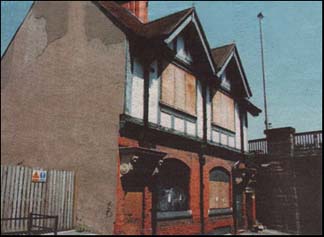 The Jolly Miller Inn (no. 35, next to City Road bridge: illustrated left). The licencee in 1919-20 was T Gough, in 1934-6 H F Haswell, in 1942, Mrs E A Haswell. Our photograph shows it boarded up, just before demolition in 1997. More photographs may be seen in our lost pubs gallery. The Jolly Miller Inn (no. 35, next to City Road bridge: illustrated left). The licencee in 1919-20 was T Gough, in 1934-6 H F Haswell, in 1942, Mrs E A Haswell. Our photograph shows it boarded up, just before demolition in 1997. More photographs may be seen in our lost pubs gallery.
Linenhall Street. This includes listings for the street's earlier name, Lower Lane ("the street leading to the Crofts"). In 1836, the Chester author and guide Joseph Hemingway described it as "a miserable receptacle of vice, chiefly inhabited by the lowest order of people".
The Cheshire Cheese Beer House traded in Linenhall Street
in 1840, licencee John Agnew.
The Sportsman's Arms (no. 4). Licencee in 1871 Isaac Taylor, in 1880 John Rice O'Hagan, in 1910-1920 William Hughes.
It stood close to Holy Trinity Church and may be seen in this detail from the 1875 Chester OS map.
The Carpenter's Arms. Pigot's Directory for the years 1818-20 lists the landlord here as J Bevan. Licencee 1822-3 R Ackerley.
The Linenhall Tavern is recorded in Pigot's Directory as trading here in 1818-20, licencee Jane Britain. She was still the licencee in 1828, Later came Samuel Peacock (also a cooper) in 1840-50, Hugh Peters in 1855, James Whitlow in 1880, Henry Peat 1902, M Cash 1919-20.
The George & Dragon (no 21). Pigot's Directory 1818-20 lists The George & Dragon, licencee George Walker, trading in Lower Lane. He was still there in 1840. Listed in the 1890 Kelly's Directory of Cheshire. in 1850 the licencee was James Walker, in 1857 W Davies, in 1880 George Simpson.
The George Public House is listed in Cowdroy's Directory in 1782, its licencee being Mrs Kerney. An earlier name for The George & Dragon above? Another George & Dragon was trading at this time in Upper Northgate Street- and continues to do so today.
The Harp Tavern. Listed in Pigot's 1828-1829 Directory when the licencee was Robert Owens. In 1840 Joseph Turner was the proprietor.
The Manchester Arms. Listed in the History, Gazetteer & Directory of Cheshire, 1850 when the licencee was Samuel Sproston. Another Manchester Arms existed in Cuppin Street.
The White Lion was trading in Lower Lane in 1781 when the licencee was Mr Cooper.
Liverpool Road (Upton): The Brewer's Arms: rebuilt and renamed The Frog. After a long period of closure, this pleasant little pub reopened in September 2014- but the last time we looked, in 2015, it had sadly closed again... Licencee in 1919-20, J Morris, in 1934 Mrs R F Archer, in 1942
Mrs Kathleen Archer.
"No, sir, there is nothing which has yet been contrived by man by which so much happiness is produced as by a good tavern or inn". Dr Samuel Johnson
Love Street: The Mansion House.
Built in the 1780s as the town residence of the Barnston family of Crewe Hill, Forest House was the largest and grandest private house in Georgian Chester. After Sir Roger, the last of the Barnstons, died in 1837, the house became auction rooms and then served as a furniture depository, its wings were demolished- only the central block survives- and their site as well as the extensive gardens built upon. A branch of the Co-Op opened there around 1909 and the building housed a tea rooms/dancehall in the 1940s and 50s.
In the 1970s, it became a live music venue called Smarties (Smarty's?) where bands including The Cure, Adam and the Ants and The Pretenders performed. It eventually hosted a bewildering succession of night clubs including Angel's, High Society, Raphael's and, finally, Love Street until, in 2004 it was extensively- and very expensively- restored by Lee's Brewery, bringing back to view many remarkable architectural features which, during its nightclub phase had fortunately remained concealed and forgotten- but well protected- behind utilitarian panelling.
The result was The Mansion House- a complex of bars, restaurants and dance floors designed to appeal to a slightly older and more 'discerning' clientelle than were currently being catered for by Brannigan's just across the road and suchlike venues in the area. Sadly, the enterprise failed financially and The Mansion House closed within the year. In 2009, however, it reopened as part of the Wetherspoon's chain and continues to thrive as such today.
Which is more than can be said of Brannigan's.
The 1871 census lists The Golden Lion Inn trading at no. 2 Love Street.
As may be seen in this detail of the 1875 Chester OS map (which also features Forest House), it was located just past the corner of Foregate Street on the left hand side, walking towards Grosvenor Park- a site now occupied by the old ABC Regal cinema recently vacated by Brannigan's.
Can we assume that it and its neighbouring properties were demolished to make way for the cinema?
Its licencee, according to the 1871 census, was Jane Price, assisted by her widowed mother Ann Dunn. (thanks to her descendant Ros Allen for that information. She is keen to find out more about this. If you can help, contact us and we'll pass it on).
Lower Lane: See Linenhall Street above.
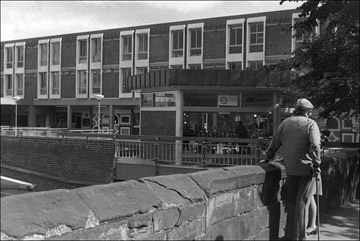 Mercia Square: In March 2003, Jason wrote to us,
"Not sure if this falls into the category (of 'vanished Chester pubs') or is long enough ago, but when you used to be able to walk thru Mercia Square to the sweet kiosk in the middle and the back bit of W H Smiths (for records) there was a wine bar called Dukes (the old pumphouse?) and across from it was another that backed onto the walls.. Pierre Griff ( not sure of spelling or if that's the right name- it was something like that ) anyway... they are part of my memories of that area". Thanks for that Jason. Anybody got photographs or further details of these places? Mercia Square: In March 2003, Jason wrote to us,
"Not sure if this falls into the category (of 'vanished Chester pubs') or is long enough ago, but when you used to be able to walk thru Mercia Square to the sweet kiosk in the middle and the back bit of W H Smiths (for records) there was a wine bar called Dukes (the old pumphouse?) and across from it was another that backed onto the walls.. Pierre Griff ( not sure of spelling or if that's the right name- it was something like that ) anyway... they are part of my memories of that area". Thanks for that Jason. Anybody got photographs or further details of these places?
A couple of years later, Jan 2005, Andy Wressell wrote to us as follows- "Firstly may I say how wonderfully absorbing your website is, I must have spent hours going from one link to another. As a Cestrian myself of 41 years many dormant memories of pubs and other buildings long gone were dusted off and recalled. I particularly enjoyed reading about Mercia Square and its bars. I remember the bar/restaurant on the upper level of Mercia Square called Dukes Wine Bar. When you entered through the glass door you found yourself in a dark room with an L-shaped bar straight in front of you. Its restaurant was to the left of the entrance and I seem to remember wagon wheels were the theme here decorating the walls.
Next to Dukes, with an adjoining internal door, was a bar called The Pump Room. I also recall this bar had a revolving door leading from the square. The decor here was old wooden barrels used as tables.
Also on Mercia Square was the wine bar Pierre Griff's, with its 'P.Gs' motif in the window with what could only be described as a drunken cherub straddling a barrel. Inside, wine bottle candleholders covered with an unbelievable amount of melted wax were the centrepiece of each table. This wine bar must have been responsible for introducing many a young Cestrian to the pleasures of wine drinking as beers and spirits were not served here.
Mercia Square was always alive with a happy atmosphere; laughter echoed as many drinkers would spill out from the bars to enjoy the summer night air. Friends would use the square as a meeting point and inadvertently spend the rest of the evening there lost in time".
Also in Mercia Square was Deering's. The Chester artist Jill Pears told us, "Deering's and Pierre Griff's were in Mercia Square, Frodsham Strreet. On the patio area, Deering's was on the left, a long bar decorated in typical 80s glitzy-style with bold metallic striped wallpaper and copper-topped tables. Pierre Griff's was at the far end with individual shops in between. It had theatre-style spotlights and cafe-style bench seats. Everyone seemed to sit around drinking pina coladas and such like. Before Mercia Square was built, I remember there being a Blue Star garage there".
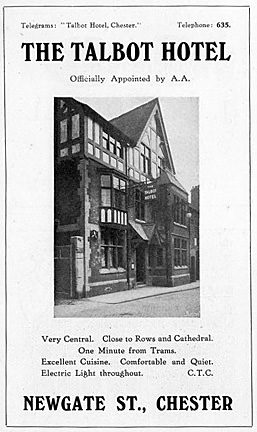 Milton Street: The Star. This beerhouse was mentioned in the Chester Chronicle, 26 June 1840, under the heading 'Police Intelligence': Milton Street: The Star. This beerhouse was mentioned in the Chester Chronicle, 26 June 1840, under the heading 'Police Intelligence':
"Assault– A person named Turner appeared before the bench to answer the complaint of John Sant, who stated that when drinking in the Star beer-shop, Milton-street, the defendant assaulted him and bit his lip. It appeared that Mr. Turner was experimentally demonstrating to Sant how he threw his neighbours on their backs and did for them. His system of gymnastics appeared to be none of the mildest. The case however was settled between the parties".
The White Lion appears in The Post Office Directory of Cheshire in 1856 when its licencee was
G Williamson.
Walking up Milton Street from Brook Street, it was situated on the right, just past Sydney Street and opposite the bowling green.
“I would give all my fame for a pot of ale, and safety.” Shakespeare: King Henry V
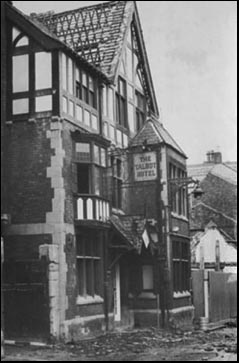 Nelson Street: The Bridgewater Hotel Nelson Street: The Bridgewater Hotel
Newgate Street: The Talbot Hotel (no 1).
Licencee in 1822-8 John Ellis, in 1880 Rebecca Jones, in 1898: Mrs Maria Elizabeth Hilton, who was still there in 1902.
In 1910 the licencee was William North Bates, in 1914 Robert McGregor Reid, during the 1950s and 60s Mr and Mrs Dunkley.
The Talbot was owned by the Duke of Westminster. The food served in the pub was cooked in the Grosvenor Hotel kitchens and carried across.
Here we see an advertisment for the Talbot and, on the right, during the course of its demolition in 1964, one of the many casualties of progress, in the inelegant form of the Grosvenor Shopping Precinct. Another photograph of its demolition is here... Recorded as being used as a polling station in 1809.
The Chester Trades Directory for 1850 lists The White Talbot trading in Newgate Street, its licencee being Benjamin Tatler. It also appears in The Post Office Directory of Cheshire in 1856, its licencee still Mr Tatler. The White Talbot was not the same house as the Talbot Hotel. The Talbot Hotel was located at the junction of Pepper Street and Newgate Street while the White Talbot was about 3/4 of the way up Newgate Street on the right hand side when going from Pepper Street to Eastgate Street. The inn is absent from the 1871 directory.
The Prince of Wales- also recorded in the 1809 polling station list. In 1818 its licencee was Robert Sammon, in 1822-3 William Culm, in 1828 Catharine Gray, in 1840 Benjamin Tattler, in 1850 James Bailey.
The Newgate Tavern (no 1 Newgate Place) Licencee in 1818 to 1840 Catherine Faulkner. (However, the period 1822-3 lists the proprietor as M Faulkner). in 1850 Martha Poole, in 1902-1910 Mrs Mary Wynn, in 1914 to at least 1920 Joseph Testi. Slater's Directory lists a pub called The Newgate trading in nearby St. John Street in 1880.
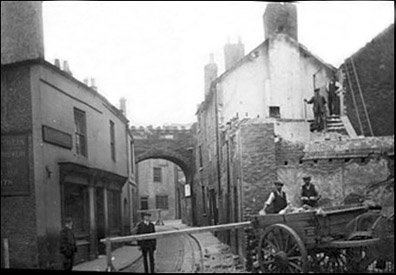 The photograph on the left shows a scene strange to us today: the
medieval
Peppergate
and
the
road
leading
to
it, Little
St. John
Street which was, until the 1930s,
extremely
narrow
and
hemmed
in
by
a
clutter
of
houses
and
small
factories,
such
as
'Poynton's
Famous
Pipe
Works', where clay pipes in the style of those used by the American Indians were manufactured, and considered by many to be the finest in England. The photograph on the left shows a scene strange to us today: the
medieval
Peppergate
and
the
road
leading
to
it, Little
St. John
Street which was, until the 1930s,
extremely
narrow
and
hemmed
in
by
a
clutter
of
houses
and
small
factories,
such
as
'Poynton's
Famous
Pipe
Works', where clay pipes in the style of those used by the American Indians were manufactured, and considered by many to be the finest in England.
The building on the left of the picture was the Newgate Tavern. Just visible rising above it is the tall tower of the Lion Brewery.
All of these buildings are long gone- indeed, the photograph seems to be a record of the commencement of demolition. Beneath the buildings on the right was discovered the lower masonry courses of the 1st century South East Corner Tower of the great Roman fortress of Deva, which is displayed today in a small park, accessed from the ancient Peppergate, under which traffic has long ceased to pass.
The old tavern and everything else on the left vanished to allow the road to be widened when the Newgate was built in the 1930s. Learn more about all this here...
The Causeway Tavern is listed in the 1871 census. An establishment with the same name existed 1873-7 in The Groves. Was the licence and name transferred there from Newgate Street?
The Rising Sun was recorded in Pigot's Directory in 1818, licencee James Tipping (still there 1822) and in 1828 when the licencee was Thomas Griffith. In 1840 it was Louisa Warbuton. Another Rising Sun was in Bridge Street Row at the same time.
Cowdroy's Directory in 1789 lists The Jolly Brewers in Newgate Street, the licencee being given simply as "Hickman, Publican".
The Swan was located in Newgate Street in 1781, proprietor Mr Lloyd.
Nicolas Street: The Castle Inn (no. 42, next door to the modern Conservative Club). This, along with an adjoining row of cottages (nos. 30-40 Nicolas Street) was demolished in 1974 and replaced by one of the mediocre modern buildings that line the Inner Ring Road. The licencee in 1840 was John Bishop, in 1850-80 Robert Wooley Evans, in 1902 Mrs E H Williams, in 1910-14 W E Higginson, in 1919-36 Mrs Clara B Higgonson. It was listed in the History, Gazetteer & Directory of Cheshire, 1850, the 1859 Post Office Directory of Cheshire and Slater's Directory 1880. You can see a number of photographs of it in our Lost Pubs Gallery.
The Brewer's Arms is listed in Pigot's Directory for 1828/9 when the licencee was George Dunbill.
The Ship. This inn was listed in Cowdroy's Directory in 1789 when the licencee was Mrs Blower.
The Post Office Directory of Cheshire for the year 1857 lists the grand-sounding Imperial Hotel at 25 Nicolas Street, and its licencee as W Phillips.
The 200 year-old Axe Tavern was for a while known as The Falchion & Firkin but now again re-named Bar Lounge. It appeared on a list of polling stations in 1809. Its landlord in 1902 was John Vernon. The ancient Yacht Inn (see Watergate Street) formerly stood on the corner of Watergate and Nicolas Streets, but when this was demolished and Nicolas Street widened, the Axe adopted that position in its place.
"From man’s sweat and God’s love, beer came into the world." Saint Arnold of Metz, the patron Saint of Brewers
Back to Chester's Vanished Pubs part I | 2 | 3 On to parts 4 | 5 | 6 | 7 | 8 | Gallery | old pub maps
"When things go wrong and will not come right,
Though you do the best you can,
When life looks black as the hour of night -
A PINT OF PLAIN IS YOUR ONLY MAN.
When money's tight and hard to get
And your horse is an also-ran,
When all you have is a heap of debt -
A PINT OF PLAIN IS YOUR ONLY MAN.
When health is bad and your heart feels strange,
And your face is pale and wan,
When doctors say you need a change,
A PINT OF PLAIN IS YOUR ONLY MAN.
When food is scarce and your larder bare
And no rashers grease your pan,
When hunger grows as your meals are rare -
A PINT OF PLAIN IS YOUR ONLY MAN.
In time of trouble and lousy strife,
You have still got a darlint plan
You still can turn to a brighter life -
A PINT OF PLAIN IS YOUR ONLY MAN".
Flann O'Brien, 'At Swim Two Birds' |
Write to us! Your contributions-
or corrections- to these pages are most welcome... |

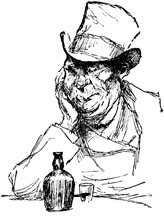

 The Dairy Maid. Listed in the History, Gazetteer & Directory of Cheshire, 1850 when its licencee was James Howarth. Slater's Directory for 1855 has John Hayes in charge. The inn does not appear in the 1871 directory.
The Dairy Maid. Listed in the History, Gazetteer & Directory of Cheshire, 1850 when its licencee was James Howarth. Slater's Directory for 1855 has John Hayes in charge. The inn does not appear in the 1871 directory.  The Duke of York (no 2, next door to the Bear's Paw- see below). Licencee in 1818-1828 James Davies, in 1840-50 William Minshull, in 1855 Thomas Copeland, in 1857 R Denson, in 1871-80 Thomas Harper, in 1902 William Lewis. In 1906-10 William Higginson was the landlord. He had previously had
The Duke of York (no 2, next door to the Bear's Paw- see below). Licencee in 1818-1828 James Davies, in 1840-50 William Minshull, in 1855 Thomas Copeland, in 1857 R Denson, in 1871-80 Thomas Harper, in 1902 William Lewis. In 1906-10 William Higginson was the landlord. He had previously had 


 The Royal
George. (No 31, illustrated right). Landlord in 1880 David Jones, in 1902 John Dunbalin, in 1919-20 Mrs Dunbabin, in 1934 A L Catherall, in 1936 Leonard Catherall (same man?), in 1942 George Catherall. After him, during 1940s was Mr Thomas Shrives Evans, who died in the pub in 1952 (he had previous to this been licencee of the
The Royal
George. (No 31, illustrated right). Landlord in 1880 David Jones, in 1902 John Dunbalin, in 1919-20 Mrs Dunbabin, in 1934 A L Catherall, in 1936 Leonard Catherall (same man?), in 1942 George Catherall. After him, during 1940s was Mr Thomas Shrives Evans, who died in the pub in 1952 (he had previous to this been licencee of the  Grosvenor Street:
Grosvenor Street: In October 2012, the Chester artist Jill Pears told us, "I remember it being one big room with the bar to the left as you went in and a big corner room upstairs. This was in the early 1980s at the time of the New Romantic era, when all the girls were going round wearing pirate shirts".
In October 2012, the Chester artist Jill Pears told us, "I remember it being one big room with the bar to the left as you went in and a big corner room upstairs. This was in the early 1980s at the time of the New Romantic era, when all the girls were going round wearing pirate shirts". Kelly's Directory for 1902 lists a Belgrave Vaults trading at 14 Grosvenor Street and 2 Cuppin Street when J Brown was the licencee.
Kelly's Directory for 1902 lists a Belgrave Vaults trading at 14 Grosvenor Street and 2 Cuppin Street when J Brown was the licencee.  The 1871 census lists The Comberman Vaults trading in Grosvenor Street.
The 1871 census lists The Comberman Vaults trading in Grosvenor Street.
 The Horse & Groom- existed in 1752 when the creditors of a bankrupt cheese merchant met there. The landlord at the time was Thomas Worsley. In 1782 the licencee was Ann Hewitt. A licencee of the same name was recorded in Pigot's Directory as being there in 1818. In 1822-3 the landlady was- you guessed it- Ann Hewitt! The same landlady in charge for over forty years?
The Horse & Groom- existed in 1752 when the creditors of a bankrupt cheese merchant met there. The landlord at the time was Thomas Worsley. In 1782 the licencee was Ann Hewitt. A licencee of the same name was recorded in Pigot's Directory as being there in 1818. In 1822-3 the landlady was- you guessed it- Ann Hewitt! The same landlady in charge for over forty years? The Hare and Hounds Tavern (illustrated left and below) was remarkable for its variations of address- 149 and 117 Handbridge, Old Wrexham Road and 51 & 81 Overleigh Road. The landlord in 1781 was John Morgan, in 1818-28 Edward Phillips, in 1840 Thomas Jones, in 1850 Edward Neild, in 1857 T Jones, in 1880 Edward Blacow, in 1919-20 John Hanmer.
The Hare and Hounds Tavern (illustrated left and below) was remarkable for its variations of address- 149 and 117 Handbridge, Old Wrexham Road and 51 & 81 Overleigh Road. The landlord in 1781 was John Morgan, in 1818-28 Edward Phillips, in 1840 Thomas Jones, in 1850 Edward Neild, in 1857 T Jones, in 1880 Edward Blacow, in 1919-20 John Hanmer. The King's Arms stood next door to the Hare &Hounds- the white house in this photograph. Its landlord in 1818-28 was James Murphy, in 1840 Daniel Davies, in 1871 Hiam Ives, in 1880 Thomas P Garrett, in 1902 Mrs Betsy Speed, in 1910 Joseph Speed, in 1919 to at least 1920 "Mrs Speed". The Speed Family were licencees for the last 30 years of its existence. It closed in 1922 (this seems to have been a year of mass extinction for Handbridge pubs).
The King's Arms stood next door to the Hare &Hounds- the white house in this photograph. Its landlord in 1818-28 was James Murphy, in 1840 Daniel Davies, in 1871 Hiam Ives, in 1880 Thomas P Garrett, in 1902 Mrs Betsy Speed, in 1910 Joseph Speed, in 1919 to at least 1920 "Mrs Speed". The Speed Family were licencees for the last 30 years of its existence. It closed in 1922 (this seems to have been a year of mass extinction for Handbridge pubs). 



 MARY ARTINGSTALL, of FLOOKERSBROOK, near this City, Begs leave to inform the Friends of her late Husband, John Artingstall, deceased, THAT she intends to continue the PUBLIC BUSINESS, as usual, at the Sign of the Ermine, in Flookersbrook aforesaid; and also to carry on the MAKING of MALT, under the Management of the Person employed by her late Husband, to whose Friends she returns her sincere Thanks; and assures them and the Public in general, that those who will please to favour her with their Commands, shall be served with the above Article upon the best and most reasonable Terms,
MARY ARTINGSTALL, of FLOOKERSBROOK, near this City, Begs leave to inform the Friends of her late Husband, John Artingstall, deceased, THAT she intends to continue the PUBLIC BUSINESS, as usual, at the Sign of the Ermine, in Flookersbrook aforesaid; and also to carry on the MAKING of MALT, under the Management of the Person employed by her late Husband, to whose Friends she returns her sincere Thanks; and assures them and the Public in general, that those who will please to favour her with their Commands, shall be served with the above Article upon the best and most reasonable Terms, The Beehive Hotel, 15 Hoole Road (left)
closed as recently as the Spring of 2011 and has become a branch of audio/video retailers Richer Sounds- who moved here from another of Chester's 'lost pubs',
The Beehive Hotel, 15 Hoole Road (left)
closed as recently as the Spring of 2011 and has become a branch of audio/video retailers Richer Sounds- who moved here from another of Chester's 'lost pubs', 


 Mercia Square
Mercia Square

